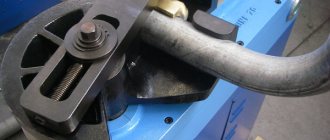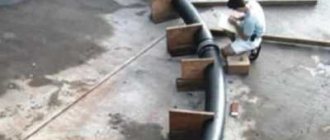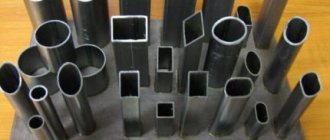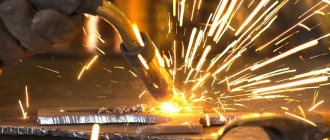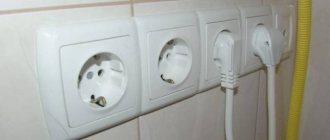What is the difficulty of bending profile pipes?
Regardless of the shape of the pipe profile, the essence of the bending process is to give the product a partial or full bend. This can only be achieved by applying a certain external influence - exclusively pressure or a combination of heat and pressure.
From the point of view of physics, during the bending process, two multidirectional forces simultaneously act on the profile pipe:
- Tensile force. Appears on the outside of the bend.
- Compression force. Directed towards the inside of the bending area.
The opposite direction of these forces is precisely responsible for some of the difficulties that often arise in the process of bending pipes:
- Different sections of the pipe in the bending zone may change shape differently, which will inevitably lead to a violation of their alignment.
- The pipe wall on the outside of the bend may lose strength or even burst under strong tension.
- On the inside of the bend, on the contrary, folds often form during compression.
To avoid these troubles and not get a crumpled metal surface instead of a smoothly curved pipe, you should definitely take into account the type of material and numerous geometric parameters of the product: wall thickness, cross-section diameter, bending radius. Knowing these characteristics will allow you to choose the optimal bending method.
Note! Experts say that it is better not to bend profile pipes with a wall thickness of less than 2 mm. The strength at the bend points will be quite low, even with perfect adherence to the technology. For such pipes it is better to prefer welded joints.
Profile preparation
Preparing a profile for bending depends on the length of the workpiece and takes an average of 15 to 20 minutes, and the bending process itself takes 7 to 8 minutes. First, the profile blank is marked taking into account the technological segments. To avoid flattening of the profile walls, cracks and bruises during the bending process, the profile chambers are tightly packed with quartz sand. To ensure that the packing is not loose and does not lead to flattening in the bend area, as the chambers are filled, the walls of the profile are tapped from top to bottom, thus compacting the sand. Then the profile must be closed at both ends with plugs so that sand does not spill out of the profile during the bending process. Sand is not thrown away after use, because... after the next use, the quality of the sand only improves (sand fractions become smaller during the bending process) and it can be used repeatedly. Before bending, profiles and rollers must be lubricated with thick oil to reduce friction between the surfaces of the rollers and the outer walls of the profile.
The principle of using a pipe bender
It is not always possible to bend a profile pipe (especially for large-diameter products) with your own hands. For these purposes, there are special devices - pipe benders. A standard pipe bender is equipped with a drive wheel, which, moving along one of the edges, carefully bends the pipe section in the required direction.
There are two types of pipe benders:
- Manual. The wheel of the device is operated manually using a special handle. Well suited for pipes with a small cross-sectional area.
- Electrical. The use of such devices is justified in cases where the volume of work is quite large, and the pipes themselves have substantial dimensions. The device is connected to a standard power supply, and the wheel moves by means of an electric drive. Allows you to obtain smoother products with significant time savings.
If the work is one-time, purchasing your own pipe bender may not be profitable. In this case, you should consider renting the device, or consider one of the alternative bending methods.
Is it possible to bend a pipe at home?
If the pipe does not have the largest dimensions, and bending accuracy is not a critical parameter, it is possible to carry out the necessary work at home.
Of course, it will be better if there is a separate room for this work, equipped with a workbench, a vice and other necessary tools. In addition, during the work you will most likely have to use an angle grinder, a welding machine or an open flame source. Agree, a private house or apartment is not suitable for this.
Another important tip. Metal is a fairly elastic material that, after any deformation, will strive to regain its previous shape. For this reason, the pipe should be bent at a slightly larger angle than the design provides. The metal will return a few degrees back, and we will get exactly the bend radius that we originally expected.
Read also: What is measured in microns
To facilitate the bending procedure, the corresponding section of the pipe can be preheated. The hot metal becomes more ductile and pliable, which greatly facilitates the process. For warming up, they most often use:
The pipe is thoroughly heated at the site of the future bend (the length of the heating site is taken to be equal to six pipe diameters).
It is worth remembering that repeated cycles of intense heating and cooling inevitably make the metal more brittle.
At 90 degrees
Almost all buildings have a rectangular shape, so the most common action with corners is the need to bend them at 90 degrees.
Bend the corners 90 degrees for the future frame is quite simple. First you need to make a development in the place of the future fold. To do this, mark two corners on one of the shelves in different directions from the normal, 45 degrees each, and cut them out with a grinder. Carefully and slowly bend the corner and weld the cut area using electric welding; it is recommended to preheat the bend area so that the second shelf does not crack or break during bending.
Acceptable design dimensions for correctly marking and bending metal corners at 90 degrees are shown in the table:
Source
Alternative bending methods
Fortunately, you don't need any special equipment to bend pipes. People's ingenuity has long invented more than one way to achieve the desired result without using a pipe bender.
We use an angle grinder
In the area where it is necessary to bend the pipe using a grinder, several cross cuts are made. The smaller the bend radius, the more cuts will be needed. In most cases, three is enough. Next, the profile pipe is bent without much effort, and the cut points are sealed using welding.
If the welded areas are carefully sanded, the resulting product will look very decent . There will be no folds or significant loss of strength at the bend. But this method will not give ideal roundness, because the bend will consist of several straight sections located at an angle to each other.
Spring method
To make a spring you will need steel wire with a cross section of 2 mm. The wire is bent to the shape of the profile so that the side of each segment is several millimeters smaller than the corresponding side of the pipe profile and can move freely along its internal length.
Next, the spring is simply inserted into the pipe and bent to the required radius. To facilitate the bending procedure, the pipe section can be heated.
Note! To avoid problems with removing the spring from the cavity of the profile pipe after the bending procedure, a piece of wire should be securely attached to its nearest end.
Filling the pipe with sand
This method is striking in its simplicity and efficiency, because all the necessary materials are literally under your feet:
- We first prepare two wooden wedges that can tightly close the pipe cavity.
- We hammer the wooden wedge tightly into the end of the pipe.
- We fill the pipe with sand, previously sifted and dried.
- We drive in the second wedge.
Next, one of the ends of the pipe is fixed and bent. To facilitate the procedure, the pipe section can also be heated. At the end of the work, the wedges are removed and the sand is poured out.
Using a dense sand bed will help prevent warping by ensuring an even and strong bend.
Plain water will help
One end of the profile pipe is closed with a plug, after which water is poured into the cavity. An indispensable condition is the presence of a negative temperature sufficient to freeze the liquid. After the water freezes, the pipe will bend without any problems, and the bend will be beautiful and durable.
It is important! The method is suitable for pipes made of non-ferrous metals that are not subject to corrosion.
Necessary equipment
To perform work on bending a profile pipe without using a special pipe bender, you will need one of these simple devices:
- Elementary lever with a template.
- A horizontal plate with several holes in which metal stops of the appropriate diameter are arranged. The device is well suited for pipes made of soft metals, or products with a low profile height (no more than 10 mm). Filigree precision cannot be achieved here. In addition, significant physical effort may be required.
- Roller devices. One end is securely fixed in a vice, and a roller is applied to the bend, which, with appropriate physical impact, will ensure an even bend of the required radius.
- Special mandrel. The device is a kind of template made of thick plywood or wood. With some effort, the pipe can be placed on the mandrel, giving it its bending radius. The device will be useful if it is necessary to frequently perform work on bending profile pipes.
Read also: How to check an electric motor capacitor with a multimeter
Today, many DIYers use aluminum for almost everything. Its characteristics allow it to be used without any problems for furniture, for creating garage accessories, etc.
Tsvetprokat aluminum corner offers to purchase on the most favorable terms. This publication will describe various techniques that will make it possible to bend aluminum without damaging it. If you start bending an aluminum part mechanically, cracks may appear in the metal and the part will simply break at the bending point.
Features of production, properties of aluminum pipes
Aluminum pipe profiles are divided into three groups according to production method:
- cold-worked;
- pressed;
- welded
Rolled aluminum pipes are produced in different ways
The first position is aluminum pipes with a diameter of 6-150 mm. They are for general industrial purposes and are produced according to GOST under the number 18475-87.
The essence of the technology is that an aluminum blank is taken and a through hole is drilled along the axis. Then the workpiece is rolled between rollers, forming a cross-section of the finished product.
The second position is aluminum pipes with a diameter of 6-220 mm, manufactured according to GOST 18482-79. The technology is based on the method of pressing a heated workpiece on a special mill. The workpiece is placed on the matrix and pressed until the required shape is formed. Next, the semi-finished product is rolled on a mill through rollers.
The third position is aluminum pipes, made either from sheets or from tape, also known as strips, by twisting and welding along the seam on the inside and outside. The final step is necessarily hot tempering of the finished product. The reason is the relief of internal stresses in the welding areas.
Aluminum pipes can be divided into two further categories based on wall thickness:
- up to 5 mm – thin-walled;
- more than 5 mm – thick-walled.
Thick-walled modifications
During the production process, additional operations are often used that improve technical and operational characteristics. It's all about the metal itself. At temperatures below +20°C, deformation may cause the structure to break. Therefore, either heat treatment is used, for example, annealing or hardening, or mechanical processing - cold hardening, another name is cold hardening.
Both improvement options make it possible to make hard and durable metal out of ductile and soft metal. It is these profiles that are used in different designs.
And yet, high ductility is the main advantage of aluminum pipes. That is, it is not difficult to deform or bend the product, but it does not lose its qualities and properties.
Where are aluminum products used?
The scope of use is wide. Reasons for popularity:
- Aluminum products do not require special maintenance;
- ease of the resulting structures;
- ease of transportation and installation, including if the product needs to be bent.
Main areas of application:
- Agriculture. Drainage and watering systems are constructed from aluminum pipes, and fences for small animals and plants are assembled.
- Oil production. Aluminum pipes are inert to petroleum products and do not change their characteristics under their influence.
- Ventilation systems. Aluminum products are easy to deform, cut and drill; they can simply be bent, which simplifies the process of installing ventilation air ducts and shafts.
- Construction. Frames for gazebos, hangars and canopies are made from aluminum pipes. They make railings, canopies, fences. Today, they are increasingly using curtained facades in the construction.
- Furniture – chairs, armchairs, tables, etc.
- Advertising – billboards, stands, frames for display cases.
Using a homemade rolling machine
A homemade machine can be made from everything you have at hand:
Everything, of course, depends on the dimensions of the aluminum profile itself, as well as on the required bending radius. Such homemade machines allow you to achieve very positive results, in principle, without heating the part.
Success is achieved through gradual, slow bending over a large area. As a result, local stresses do not arise in the metal. You can be sure that cracks will not appear.
However, there is an easier way. All you need is a gas burner and large pieces of wood. Initially, it should be noted that you will not get the expected result the first time. To understand the technique, it is recommended to practice cutting the profile.
Roll Forming Mill
Bent profiles - both aluminum and steel - are produced on special roll-forming units - roll-forming lines. The process of manufacturing bent profiles is called profiling. Roll forming is a metal working process in which a piece of sheet metal is gradually formed through a series of bending operations into a bent profile. This process takes place on a roll forming line - a roll forming mill, where the sheet blank passes through several roll stands. These rolls, which sometimes look like rollers, can be positioned above and below the workpiece, along its edges, at an angle to it, and so on. As the sheet passes through each roll stand, it undergoes plastic deformation and bending. Each roll stand performs one step in the complete belt bending sequence to form the finished bent section.
Figure – Roll Forming Mill (Source: custompartnet.com)
Profile bending with a gas torch
Using a gas torch, it is necessary to heat the aluminum profile exactly at the bending point and next to it. The main heat of the flame should be concentrated at the point of bending.
After the required temperature has been reached and the profile has become noticeably more plastic, a steel metal pipe of suitable diameter is applied to the bending metal. Strictly speaking, its outer diameter will be equal to the bending diameter of the aluminum profile.
It is necessary to work with thick gloves, as the metal becomes very hot. Leaning the pipe against the profile, we begin to carefully bend it. Apply jerky, soft movements (you don’t have to constantly pull the profile to bend).
We watch the place of bending. If we see a change in color, continue heating with a gas burner. The final result will be achieved much faster than using homemade rolling machines.
The video demonstrates how you can bend an aluminum profile at home:
Aluminum is a lightweight and practical material that is often used to install various structures at home. If it is necessary to obtain a bent workpiece, this is easy to do, which is facilitated by the low melting point and ductility. How aluminum profiles are bent at enterprises and at home is described in detail below.
Work specifics
There is only one difficulty when deforming an aluminum workpiece. Although the material is very plastic, cracks may appear at the bend, and the profile itself may not bend as smoothly as we would like. But this does not always happen, and more often due to a person’s lack of experience. If you use modern equipment (which is available not only for large enterprises), the problem will not even manifest itself.
For work at home, you will not need the cheapest equipment. It is recommended to purchase it only if bending aluminum is part of regularly performed work. Now - about methods of bending a profile with and without machines.
Equipment classification
It is possible to obtain a curved aluminum part with the most accurate required radius and minimal material loss by using roll forming devices. Conventionally, they are divided into 2 groups depending on their dimensions:
- on a fixed frame (large);
- portable (small).
Another classification criterion is the fold itself. So, the machine can bend the workpiece:
- along a given radius;
- at a given or right angle.
Read more about representatives of certain groups below.
Bending process
To set up a roll forming machine, regardless of quantity, 2-3 profiles are usually required. Wall thickness, shelf life of the aluminum profile, the state of its delivery and the geometric characteristics of the profile - all these indicators affect the possibility of bending the profile with a particular radius and the subsequent quality of the arc. The minimum radius also depends on the profile width. For a quality system profile with a width of 45 to 50 mm, a minimum radius of 150 to 175 mm can be achieved. The rollers must slide freely along the profile flanges, otherwise the profile may curl; this fact is taken into account when installing the clamp. The surface of the rollers must be clean to avoid scoring and scratches on the profile being processed. Due to the fact that the profile blank is coated with oil, along with the lubricant, dust and grains of sand fall on the walls of the rollers, which scratch the surface of the profile. Also, during bending of an unpainted profile, particles of aluminum oxide can be torn off by the force of friction from the cladding layer of aluminum (a thin layer of pure aluminum), which are smeared over the deformed surface and scratch the walls of the profile and rollers. Therefore, during the bending process, periodically wipe the rollers with a clean rag and remove accumulated dirt from them. The main indicator of the quality of a bent profile is the preservation of a constant cross-section, the absence of metal corrugations on the inner edge of the profile, the parallelism of the front walls of the profile, undeformed grooves for installing glazing beads and seals.
Stationary equipment
An example of a large machine whose task is to bend an aluminum profile along a radius is a profile bending machine. The main working parts of the equipment are stationary and movable rollers, the geometry of which follows the contour of the workpiece in cross section. Based on the number of videos, they are divided into groups:
Read also: DIY devices for cutting logs with a chainsaw
The first two rollers rotate in the same direction and are on the same line, feeding the profile to the third roller, rotating in the opposite direction. By adjusting the distance between two co-directed elements, the master changes the bend radius of the aluminum workpiece. If a very small radius is required, several passes are made through the rollers.
Four-roller machines are used for bending profiles of complex shapes (circles, spirals, etc.). Two rollers are also stationary and co-directed, while the other two bend the non-standard product. The radius can be adjusted with your own hands, or on a computer if there is electronic control.
The position of the rollers may vary on machines. It happens:
The former are suitable for elements with a large cross-section (up to 300 mm in height), the latter - for small workpieces (rolled products) or particularly complex materials (window profiles). Now a few words about angle bending devices.
Portable equipment
An example of such a unit is the ALS profile bending machine. Its task is to bend strips and metal profiles of complex shapes up to 160 mm wide and up to 2 mm thick. It is most often used for bending wide profiles (for example, when installing outdoor advertising - volumetric letters), but it is also suitable for small ones.
Distinctive features of the ALS machine:
- there is no need to attach to a workbench - the built-in support is sufficient;
- ease of transportation due to small dimensions and weight;
- the action takes one second.
The most popular devices of this format are “ALS-A 90” and “ALS-A 60”. The first bend the workpiece by 90 degrees, the second by 60. The cost of “ALS” is about 6,000 rubles.
Profile bending at home
Surely those who regularly carry out repairs have wondered how to bend an aluminum profile without expensive equipment. Below are several ways to do the job yourself.
Method 1. Vise and bars
For open profiles (for example, U-shaped), it will be necessary to prevent the loss of stability of the walls. To do this, you need to use a block-liner, preferably metal, that fits exactly into the groove of the groove. The sequence of actions of the wizard is as follows:
- put the liner inside the profile;
- clamp the workpiece in a vice so that the edges of the liner and the lips of the vice coincide;
- bend the profile slightly;
- Unclench the vice and extend the profile half a millimeter;
- repeat the two steps described above until the required bent profile is obtained.
The method is simple, but far from accurate - it is difficult to get an even product the first time, but an experienced craftsman will be able to correct the geometry.
Method 2. Homemade videos
The simplest way to create an analogue of a roll forming machine involves the following steps:
- buy 2-4 rollers of small diameter with a width slightly exceeding the height of the blank profile;
- fix the product on a flat horizontal surface so that they can rotate freely, and the distance between them is sufficient for the passage of the profile.
That's all. To bend the workpiece into a circle, two rollers will be enough; to obtain a product of a certain radius - at least three, and it is better to make one of them adjustable, by analogy with profile bending machines. A metal product is inserted between the rollers and carefully scrolled. The user controls the applied force, the progress of work and holds the workpiece.
The DIY methods described above are an alternative to expensive methods of working with equipment. If it is possible, and bending of metal blanks is carried out regularly, you should think about purchasing at least a compact device at a price of 10 thousand rubles. If you can give recommendations on ways to bend aluminum profiles of various shapes, please share the information in the discussion for the article.
Conditions of grades of aluminum and aluminum alloys
Bent profiles are manufactured and supplied from:
- aluminum grades AD0 and AD1 in M condition (annealed);
- aluminum alloys D1, D16, AMg3, AMg6 and VD1 in the M state (annealed);
- aluminum-manganese alloy AMts in the following states: – M (annealed); – H2 (semi-hardened); – N (cold-hardened);
- aluminum-magnesium alloy AMg2 in the following states: – M (annealed); – H1 (quarter hardened); – H2 (semi-hardened); – H3 (three-quarter hardened); – N (cold-hardened).
